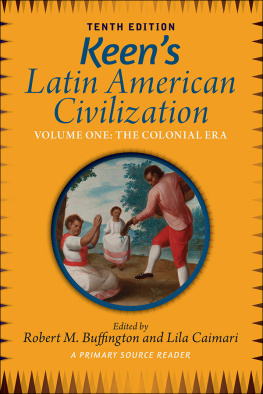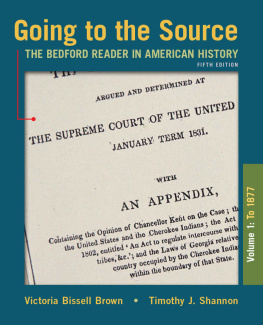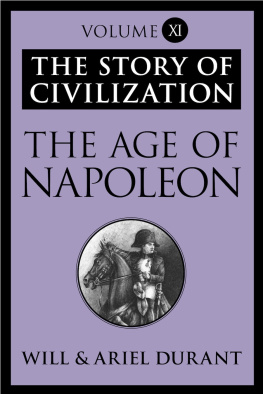First published 2016 by Westview Press
Published 2018 by Routledge
711 Third Avenue, New York, NY 10017, USA
2 Park Square, Milton Park, Abingdon, Oxon OX14 4RN
Routledge is an imprint of the Taylor & Francis Group, an informa business
Copyright 2016 by Taylor & Francis
All rights reserved. No part of this book may be reprinted or reproduced or utilised in any form or by any electronic, mechanical, or other means, now known or hereafter invented, including photocopying and recording, or in any information storage or retrieval system, without permission in writing from the publishers.
Notice:
Product or corporate names may be trademarks or registered trademarks, and are used only for identification and explanation without intent to infringe.
Every effort has been made to secure required permissions for all text, images, maps, and other art reprinted in this volume.
Cover Photo: De Barcino, y Mulata, China (From Barcino and Mulata, China), 1785, Francisco Clapera. Denver Art Museum: Permanent Collection, Gift of Frederick and Jan Mayer. Photograph courtesy of Denver Art Museum.
Designed by Trish Wilkinson
Set in 11-point Arno Pro
Library of Congress Cataloging-in-Publication Data
Keens Latin American civilization: primary source reader / edited by Robert Buffington, University of Colorado Boulder, Lila Caimari, Universidad de San Andrs, Buenos Aires.
Tenth edition.
2 volumes cm
Includes bibliographical references and index.
Contents: Volume 1. The colonial era Volume 2. The modern era.
ISBN 978-0-8133-4889-6 (v. 1: pbk.) ISBN 978-0-8133-4890-2 (v. 1: e-book) ISBN 978-0-8133-4891-9 v. 2: pbk.) ISBN 978-0-8133-4892-6 (v. 2: e-book)
1. Latin AmericaCivilization. 2. SpainColoniesAmericaHistory. 3. Latin AmericaHistory. I. Buffington, Robert, 1952 II. Caimari, Lila M., 1962
III. Keen, Benjamin, 1913
F1408.3.L274 2015
980dc232014047541
ISBN 13: 978-0-8133-4889-6 (pbk)
This tenth edition of Keens Latin American Civilization responds to numerous requests from teachers and reviewers for a two-volume text that better fits the way most of us teach the undergraduate Latin American history survey with two semester-length courses, one devoted to the colonial period and another to the modern era. Another request was that we update some of Benjamin Keens introductions to reflect changes in the way historians talk about concepts like feudalism in early modern Spain and to tone down some of the cultural overgeneralizations. We did this as unobtrusively as possible so as not to deaden Keens lively, accessible style, which we suspect is one reason for the books continued success. Again in response to repeated requests, we have provided dates, titles, and authors for all the sources in each introduction, and noted authorial biases wherever possible, especially when those biases were not self-evident. This should make it much easier for readers, especially students, to evaluate the reliability and relevance of the different sources. Also of interest to teachers and students will be an expanded glossary of unfamiliar terms and Internet links to many of the original sources.
One benefit of dividing the book into two volumes is that we had more space for new additions to the colonial period sources. Two of these new additions involved providing images for written texts. The first set of six images comes from a popular 1593 edition of German explorer Hans Stadens lurid account of his captivity by Brazilian cannibals. The engravings by Theodor de Bry include two images of Tupi Indians butchering, cooking, and eating their captives, two images of Tupi rituals, and two images of conquest-era violence in Spanish America. Coupled with Andr Thevets similarly lurid account of the Tupi and their curious customs, these images reveal the European fascination with Native American cultures, especially cannibalism, and expose the ways in which sensational accounts of Indian inhumanity, bolstered by graphic images, helped justify an often brutal conquest. The second set of new images, six late-eighteenth-century Mexican casta paintings by Francisco Clapera, depicts race mixture and mixed-race cultural practices in a series of nuclear family groups (father, mother, child). These images complement the readings on race relations in , especially the excerpt on The Structure of Caste and Class from Jorge Juan and Antonio Ulloas Voyage to South America, and put human faces to the intense social anxieties produced by generations of racial and cultural mixing and the consequent growth of a mixed-race population.
As more than one reviewer pointed out, two of the colonial period readings by Mexican historian Lucas Alaman in the chapter on Colonial Political and Religious Institutions were not primary sources at all but after-the-fact analyses of colonial institutions. To replace Alamans ex post facto descriptions, weve added two new excerpts. The first is a selection from the famous 1542 New Laws of the Indies for the Good Treatment and Preservation of the Indians, which proved impossible to enforce but nonetheless provided a humanitarian language, backed by actual laws, that sought to buttress the legitimacy of colonial rule. The second is a detailed account by two visiting Spanish officials, Jorge Juan and Antonio Ulloa, of the rituals surrounding the installation of a new viceroy in eighteenth-century Lima, Peru, which staged imperial power as an elaborate performance designed to strengthen colonial ties and assert the authority of the Crown in its distant territories.
Earlier editions of the book included a chapter on Hispanic Society on the Eve of the Conquest that focused almost exclusively on men and masculinity (with the exception of a brief description of Queen Isabella). Although these readings reflected the masculinist ideals that underlay conquest, they left out other aspects of Hispanic gender ideologies that played and would play a central role during and after the conquest-era in the formation of colonial Latin American society. Two new readings seek to address this serious omission. The first includes selections from Fernando de Rojass La Celestina (1499), a popular playconsidered by some to be the first Spanish-language novelabout two doomed lovers, which offer considerable insight into conventional gender roles and sexual double standards in Spain at the time. The second is a selection from Saint Teresa of vilas spiritual autobiography, which reveals a side of Hispanic society that rejected conventional social identities in favor of a religious life grounded in self-renunciation and the repudiation of material wealth and social status by both women and men.
The selections from La Celestina and Saint Teresa expose a fairly traditional kind of gender trouble in Hispanic society at the time of the conquest. In contrast, the final new additionthis one to on Colonial Cultureis three short selections from Catalina de Erausos autobiographical account of her escape from a Dominican convent and subsequent adventures as a male soldier in South America. These selections bring to light an example of gender transgression in colonial Latin America that captured the imagination of a European audience, including the King of Spain, who granted Catalina a pension for his/her military service, and the Pope, who granted him/her a special dispensation to live the rest of his/her life as a man.
As always, we had lots of help with this book. A special thank-you to our Westview editor, Kelli Fillingim; without her enthusiasm, encouragement, and patience, it would probably never have happened. Thanks as well to our project editor, Cisca Schreefel, and copyeditor, Karl Yambert, who saw us through the final stages with meticulous work and good cheer. Special thanks also to the archivists and staff at the Royal Library in Copenhagen, Library of Congress, and Denver Art Museum for their help with the images. And last but never least, our deep appreciation to the eight anonymous readers for Westview Press whose excellent suggestions have made this latest edition of









